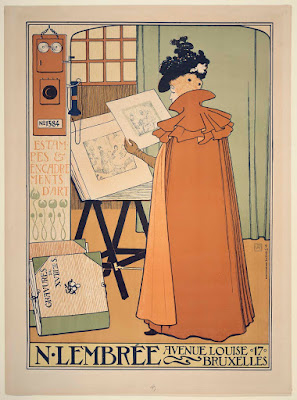 |
| Théo van Rysselberghe Sisters of the painter Schlobach 1884 oil on canvas Musée d'Art Moderne et d'Art Contemporain, Liège |
 |
| Théo van Rysselberghe Portrait of Octave Maus 1885 oil on canvas Musée Fin-de-Siècle, Brussels |
 |
| Théo van Rysselberghe Portrait of Madame Charles Maus 1890 oil on canvas Musée Fin-de-Siècle, Brussels |
 |
| Théo van Rysselberghe Portrait of Maria Sèthe 1891 oil on canvas Royal Museum of Fine Arts, Antwerp |
 |
| Théo van Rysselberghe Intimacy 1890 drawing Metropolitan Museum of Art, New York |
 |
| Théo van Rysselberghe Maria van Rysselberghe arranging her hair before a mirror 1890 drawing Metropolitan Museum of Art, New York |
 |
| Théo van Rysselberghe Coastal Scene ca. 1892 oil on canvas National Gallery, London |
 |
| Théo van Rysselberghe Big Clouds 1893 oil on canvas Indianapolis Museum of Art |
 |
| Théo van Rysselberghe Canal in Flanders in Sad Weather 1894 oil on canvas private collection |
 |
| Théo van Rysselberghe N. Lambrée Estampes & Encadrements d'Art 1897 lithograph (poster) Museum of Fine Arts, Boston |
 |
| Théo van Rysselberghe At Thuin, or, The Tennis Party ca. 1900 oil on canvas private collection |
 |
| Théo van Rysselberghe Tea in the Garden 1903 oil on canvas Musée d'Ixelles, Brussels |
 |
| Théo van Rysselberghe The Reading of Emile Verhaeren 1903 oil on canvas Museum of Fine Arts, Ghent |
 |
| Théo van Rysselberghe The Mediterranean at Le Lavandou 1904 oil on canvas Israel Museum, Jerusalem |
 |
| Théo van Rysselberghe The Fountain ca. 1917-22 oil on canvas private collection |
"Théo van Rysselberghe (1862-1926) was at the heart of the Brussels art world during the brief period in the late nineteenth century when the Belgian capital was a leading centre for the display of international avant-garde art. He was a founding member of 'Les Vingt' – the influential exhibition society, and traveled widely to see exhibitions and meet artists. His early paintings were influenced by the French Impressionists and Whistler. In Pairs in 1886, however, he saw the Post-Impressionist artist Georges Seurat's monumental 'Sunday Afternoon on the Ile de la Grande Jatte' and recognised the significance of the pointillist style. Van Rysselberghe adopted the style himself, becoming the leader of the Belgian pointillists, until he gave it up in 1904."
– from a biographical sketch at the National Gallery, London